#Water Science
Explore tagged Tumblr posts
Text
Science is so cool!
The long wavelengths of the light spectrum—red, yellow, and orange—can penetrate to approximately 15, 30, and 50 meters (49, 98, and 164 feet), respectively, while the short wavelengths of the light spectrum—violet, blue and green—can penetrate further, to the lower limits of the euphotic zone. Blue penetrates the deepest, which is why deep, clear ocean water and some tropical water appear to be blue most of the time. Moreover, clearer waters have fewer particles to affect the transmission of light, and scattering by the water itself controls color. Water in shallow coastal areas tends to contain a greater amount of particles that scatter or absorb light wavelengths differently, which is why sea water close to shore may appear more green or brown in color.
Follow @scienceisdope for more science and daily facts.
Video credit: Kendall Roberg
48K notes
·
View notes
Text
Exploring the Frontiers of Water Science: Chemistry, Purification, and Emerging Technologies
Water is the cornerstone of life, and its availability, quality, and sustainability are vital for ecosystems, human health, and industrial growth. As the global population surges and environmental challenges escalate, the demand for innovative solutions in water science has reached unprecedented levels. This article explores the dynamic fields of water chemistry, purification techniques, and…
#Advanced oxidation processes for water purification#AI in Water Management#Emerging water purification technologies#Nanotechnology in Water Treatment#Sustainable water solutions 2023#Water Science
0 notes
Text
"The substances behind the slimy strings from okra and the gel from fenugreek seeds could trap microplastics better than a commonly used synthetic polymer.
Texas researchers proposed in 2022 using these sticky natural polymers to clean up water. Now, they’ve found that okra and/or fenugreek extracts attracted and removed up to 90% of microplastics from ocean water, freshwater, and groundwater.
With funding from the U.S. Department of Energy, Rajani Srinivasan and colleagues at Tarleton State University found that the plant-based polymers from okra, fenugreek, and tamarind stick to microplastics, clumping together and sinking for easy separation from water.
In this next stage of the research, they have optimized the process for okra and fenugreek extracts and tested results in a variety of types of water.
To extract the sticky plant polymers, the team soaked sliced okra pods and blended fenugreek seeds in separate containers of water overnight. Then, researchers removed the dissolved extracts from each solution and dried them into powders.
Analyses published in the American Chemical Society journal showed that the powdered extracts contained polysaccharides, which are natural polymers. Initial tests in pure water spiked with microplastics showed that:
One gram of either powder in a quart (one liter) of water trapped microplastics the most effectively.
Dried okra and fenugreek extracts removed 67% and 93%, respectively, of the plastic in an hour.
A mixture of equal parts okra and fenugreek powder reached maximum removal efficiency (70%) within 30 minutes.
The natural polymers performed significantly better than the synthetic, commercially available polyacrylamide polymer used in wastewater treatment.
Then the researchers tested the plant extracts on real microplastic-polluted water. They collected samples from waterbodies around Texas and brought them to the lab. The plant extract removal efficiency changed depending on the original water source.
Okra worked best in ocean water (80%), fenugreek in groundwater (80-90%), and the 1:1 combination of okra and fenugreek in freshwater (77%).
The researchers hypothesize that the natural polymers had different efficiencies because each water sample had different types, sizes and shapes of microplastics.
Polyacrylamide, which is currently used to remove contaminants during wastewater treatment, has low toxicity, but its precursor acrylamide is considered toxic. Okra and fenugreek extracts could serve as biodegradable and nontoxic alternatives.
“Utilizing these plant-based extracts in water treatment will remove microplastics and other pollutants without introducing additional toxic substances to the treated water,” said Srinivasan in a media release, “thus reducing long-term health risks to the population.”
She had previously studied the use of food-grade plant extracts as non-toxic flocculants to remove textile-based pollutants from wastewater and thought, ‘Why not try microplastics?’"
-via Good News Network, May 10, 2025
#watere#water pollution#microplastics#plastic#plastic pollution#pollution#solarpunk#environment#okra#fenugreek#united states#north america#texas#environmental science#good news#hope
15K notes
·
View notes
Text
Water is amazing! I read 'The water book' by Alok Jha when I was doing my undergrad, and it was really really interesting and went in to the details of water's properties and how weird it is! I'd highly recommend it if you're interested in learning more about water being weird! :)
we should talk about water more often that shit is crazy
#water#cool science#ocean science#stem#water science#organic chemistry#environmental physics#book recommendations#non fiction
134K notes
·
View notes
Text
The only clue was the three water bottles on the table. He squeezed a drop out of each bottle onto a blotter.
“Each droplet holds all the information of the person that came into direct contact with it. Water has a memory, like a moist hard drive.”
Each circle was a differently colored, unique watermark - like a vague fingerprint – with a beautifully multi - colored dot in the center.
Except the last drop.
There was nothing. Just an empty splatter.
He frowned. “Uh-oh. Guess who’s missing a soul?”


?”
0 notes
Text

0 notes
Text
Clearest Image ever taken of Mars’ North Pole. Yes that’s water ice.
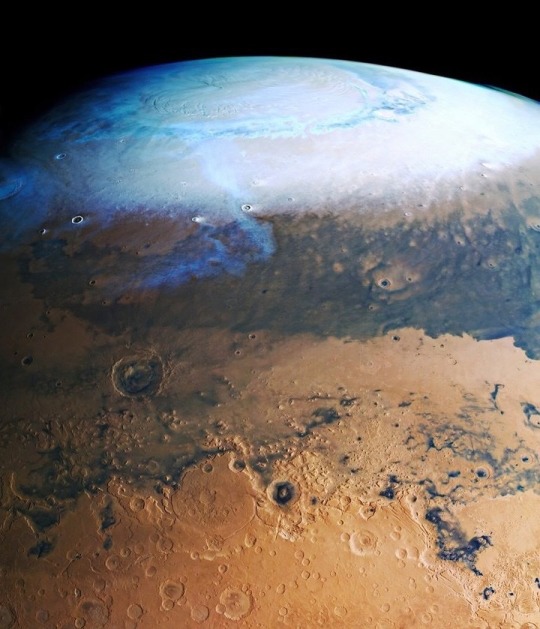
#mars posting#mars planet#water on mars#life on mars#mars#planet mars#astronomy#nasa#astronomers#universe#nasa photos#astrophotography#outer space#astrophysics#nasawebb#hubble space telescope#our universe#the universe#space exploration#space#science#space travel#space science#international space station#astronomy photography#i love astronomy#astronomy facts#astronomy picture of the day#planetary nebula#solar system
2K notes
·
View notes
Text
Unraveling the Mysteries of Water: Pressure, Flow, and Everything In Between
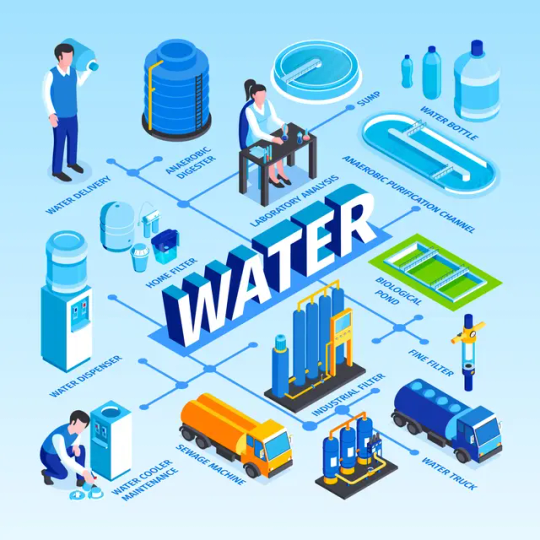
Have you ever turned on the tap, and instead of a steady gush, you get a pathetic trickle? Or maybe you’ve always wondered why sometimes the hose in the garden feels like it could knock you over, while other times it feels like a gentle summer drizzle? Well, the forces at play here are water pressure and flow.
If you've ever been curious about how they work, this post is perfect for you. Let's dive in, no pun intended, and break this down. Shall we?
Basics of Water Pressure: The Invisible Push
Water pressure is like that invisible hand that makes sure water gets from one place to another. Imagine you're blowing up a balloon. The harder you blow, the more the air pushes on the inside of the balloon, and the bigger it becomes. This push is similar to water pressure.
Now, a key player in understanding water pressure is, you guessed it, a water flow device. Such devices help measure and control how water moves. You'll find that in some places, the pressure is high because of how the water system is set up. For instance, water towers use gravity to create water pressure, making sure our homes have a steady supply.
It's important to remember that the actual flow of water isn't the pressure. The pressure is the force that drives the water. In the next point, we’ll clarify that.
Water Flow: It's All About the Move
Okay, so if water pressure is the push, then water flow is the dance! It's the actual movement of water. Think of it like this: you've got a big crowd (the water) at a concert, and the music starts. Everyone starts moving and grooving. That's your water flow.
Again, our trusty water flow device comes into play. It helps monitor and manage how swiftly or slowly that crowd is dancing. If you want a stronger flow in your shower, for example, you'll need both good water pressure to give the push and a water flow device to ensure that the water can move smoothly without any hiccups.
The relationship between pressure and flow is a delicate balance. Too much pressure and not enough flow? You've got problems. The reverse? Still problems.
The Role of the Water Flow Device
So, we've mentioned the water flow device a few times now. But what exactly is it? Well, as you've probably guessed, it's a tool that's designed to help control, measure, and manage how water flows.
In our homes, we have several water flow devices. Faucets, for example, can be considered a basic type. By turning the tap, we're adjusting a water flow device to increase or decrease the flow. More complex devices can be found in water management systems, ensuring that towns and cities have just the right amount of water flowing through them.
Thanks to these devices, we can enjoy consistent showers, fill our pools without overflowing, and water our gardens just right.
Why Pressure and Flow Matter in Daily Life
At first glance, you might think, "Why does it matter so much?" But understanding water pressure and flow is akin to understanding the rhythm of our daily lives. These elements touch upon nearly every aspect of our routine.
Imagine making your morning coffee with a trickle from your kitchen tap. It could mean waiting minutes instead of seconds to fill your pot. This not only affects your routine but also how you perceive the start of your day.
Additionally, let's talk about chores. When washing dishes or doing laundry, the right water flow ensures efficiency. With the correct pressure, your dishwasher functions optimally, ensuring clean dishes every time.
Lastly, consider the leisure and relaxation aspects. A warm bath after a long day can feel therapeutic. But if the flow is too slow, the bath might turn cold before it's full. Thanks to a consistent balance of water pressure and flow (often maintained using a water flow device), you can enjoy these little luxuries without hassle. For more details visit us at https://www.nemfg.com/.
Common Issues with Water Pressure and Flow
While we often take consistent water pressure and flow for granted, there can be moments when things don't run smoothly. Being aware of common issues can help us troubleshoot faster.
Sometimes, old plumbing systems can be the culprit. Rust, sediment buildup, or even mineral deposits can reduce the diameter of pipes, affecting flow. Imagine trying to run through a narrow alley compared to an open field.
Then, there's the problem of shared pipelines, especially in apartments or densely populated areas. If everyone decides to take a shower at the same time, you might notice a drop in your water pressure.
External factors also play a role. Seasonal changes, particularly in colder regions, can cause water to freeze in the pipes, affecting both pressure and flow. It's always a good idea to have some insulation around your pipes if you live in such areas.
Lastly, sometimes, the water flow device itself can malfunction, leading to inconsistent flow. Regular checks and maintenance can prevent or resolve such issues.
Tips and Tricks to Optimize Water Pressure and Flow
To ensure that you always have a consistent and optimal water experience, there are several steps you can take. Prevention, they say, is better than cure!
One simple trick is to schedule high water usage activities during off-peak times. For instance, if you live in an apartment, consider showering at times when it's less likely for others to do the same. This ensures you get the best pressure available.
Regularly inspecting your home's plumbing system can also help. Look out for visible leaks, rusted pipes, or any damage. Sometimes, the issue can be as minor as a washer in a faucet that needs replacing.
Water softeners can be a boon for homes in areas with hard water. They help prevent mineral buildup in your pipes, ensuring smoother water flow.
Furthermore, consider investing in adjustable water flow devices. They allow you to tweak and find a flow rate that's perfect for your needs.
Lastly, always be conscious of your water usage habits. For instance, ensure taps are closed properly and don’t leave the hose running unnecessarily. A combination of mindfulness and regular maintenance ensures a perfect water balance in your home.
Conclusion
The dance between water pressure and flow is an essential aspect of our daily lives, from that morning cup of coffee to that late-night bath. While issues might arise occasionally, with the right tips, tricks, and a keen eye on our water flow device, we can ensure smooth flow.
So, the next time you revel in a perfect shower or admire your garden being watered just right, give a nod to the science and a bit of care that made it possible.
Read More:
Driving Precision: The Role of Pressure Gauge Calibration Services in Digital Tire Monitoring
Pitot Tubes Uncovered: Mastering the Mechanics of Water Flow
The Interplay of the Pitot Tube Flow Meter with Static Pressure: A Closer Look
#Water flow device#Flow Dynamics#Water Science#Device Insights#Water Research#Flow Measurement#Pressure Analysis
0 notes
Text
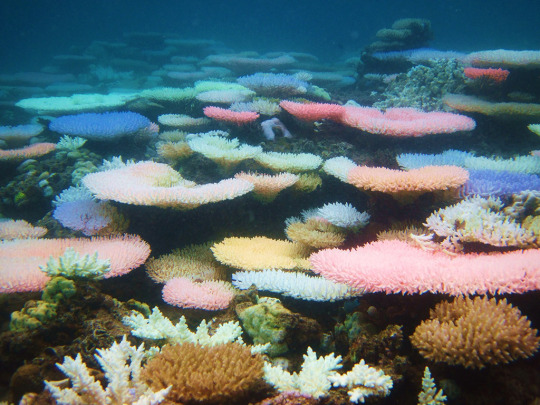
A rare moment during the process of coral bleaching
10K notes
·
View notes
Text




05.03.25 📚 *screaming* so i'm done with my take-home exam and my longest term paper which leaves me with three weeks for the remaining two papers. which should be enough time, yes, but i'm starting to feel exhausted from pushing myself every day. just a bit longer!
#my three loyal knights oj water and tea helped me battle a nasty cold#studyblr#langblr#aesthetic#study aesthetic#study inspiration#studying media science#studying linguistics#studyspo#academia#tw food
441 notes
·
View notes
Note
i like to imagine that you dont just look up random genomes, or are a bot, but rather youre a person who knows every genome
String identified: t ag tat t t a g, a a t, t at a g
Closest match: Hmm... Yes... Arcobacter butzleri ED-1 DNA, complete genome
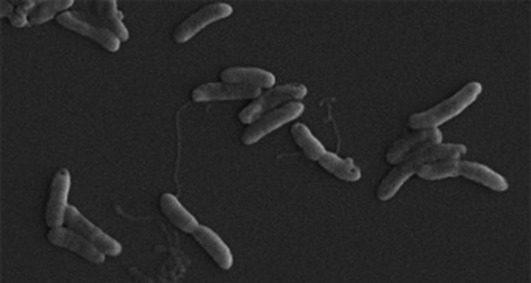
(image source)
#tumblr genetics#genetics#biology#science#asks#anon#microbes#bacteria#arcobacter#butzleri#FOOD POISONING!!!!!!!#arcobacter is characterized by being very similar to campylobacter (also causes food poisoning)#the key difference is that campylobacter is unable to grow under 30 degrees C#while arcobacter is#this makes it much harder to account for in food service!#so far arcobacter has been noted to be found in all sorts of water#as well as animal products such as pork or poultry#so remember to cook your food well!
638 notes
·
View notes
Text
“ahaha the british call THAT a heatwave” “lol british water must all be the same bc its such a small place” can u please start hating britain for real reasons and not for whatever science misinformation u have pulled out your ass
#there is a scientific definition for a heat wave and its not ‘would feel hot to chronically online americans’#the arctic has heat waves#water doesnt decide what minerals to contain based on american perception of distance#death to the uk but love and light to the natural sciences
303 notes
·
View notes
Text
PSA: quick at home electrolyte drink
if you're anything like me and you don't feel heat like you should, or you live in a normally not-hot area that's currently experiencing a heat wave, and/or you've been sipping plain water for hours and wondering why your throat is still dry and you're inexplicably exhausted, you probably need electrolytes.
in this situation your best line of defense is gatorade or some form of electrolyte tablet or powder. if you like those things, go get those things, this post is over.
BUT maybe you're also like me and you find gatorade unbearably sweet (it also gives me a headache, no idea why), and maybe you can't afford the fancy tablets or powders
if that describes you, I just did the following right here in my kitchen:
grab a big ol thermos/cold cup/giant glass of your choosing (i think mine holds 2 cups of liquid)
throw a pinch of salt in there and dissolve it in a lil bit of warm water
squeeze half a lemon in (or 1-2 tablespoons of store bought lemon juice. or lime, or orange, any citrus works tbh)
add 1-2 tablespoons of real maple syrup OR honey (maple syrup dissolves easier, honey will need a bit more warm water to melt it)
fill the rest with cold water
boom. poor man's gatorade, not too sweet, and within 20 minutes of sipping it my "mysterious" exhaustion is gone. i am very annoyed it was this easy to feel good again after languishing for hours wondering why the hell I was so tired and shaky. it was the electrolytes. it's 90 degrees out and I don't feel hot so I forgot. don't make my mistake. now go forth and hydrate!
#i'd like to add that just lemon water works for a lot of folks but it was not working for me#i needed the extra help. hope this helps some other poor chronically deydrated fool out there#i don't know why specifically maple syrup works. i saw it online and shrugged and said why the hell not. and what do you know. it works#psa#science#food#jun 2025#recipes
334 notes
·
View notes
Text
As relentless rains pounded LA, the city’s “sponge” infrastructure helped gather 8.6 billion gallons of water—enough to sustain over 100,000 households for a year.
Earlier this month, the future fell on Los Angeles. A long band of moisture in the sky, known as an atmospheric river, dumped 9 inches of rain on the city over three days—over half of what the city typically gets in a year. It’s the kind of extreme rainfall that’ll get ever more extreme as the planet warms.
The city’s water managers, though, were ready and waiting. Like other urban areas around the world, in recent years LA has been transforming into a “sponge city,” replacing impermeable surfaces, like concrete, with permeable ones, like dirt and plants. It has also built out “spreading grounds,” where water accumulates and soaks into the earth.
With traditional dams and all that newfangled spongy infrastructure, between February 4 and 7 the metropolis captured 8.6 billion gallons of stormwater, enough to provide water to 106,000 households for a year. For the rainy season in total, LA has accumulated 14.7 billion gallons.
Long reliant on snowmelt and river water piped in from afar, LA is on a quest to produce as much water as it can locally. “There's going to be a lot more rain and a lot less snow, which is going to alter the way we capture snowmelt and the aqueduct water,” says Art Castro, manager of watershed management at the Los Angeles Department of Water and Power. “Dams and spreading grounds are the workhorses of local stormwater capture for either flood protection or water supply.”
Centuries of urban-planning dogma dictates using gutters, sewers, and other infrastructure to funnel rainwater out of a metropolis as quickly as possible to prevent flooding. Given the increasingly catastrophic urban flooding seen around the world, though, that clearly isn’t working anymore, so now planners are finding clever ways to capture stormwater, treating it as an asset instead of a liability. “The problem of urban hydrology is caused by a thousand small cuts,” says Michael Kiparsky, director of the Wheeler Water Institute at UC Berkeley. “No one driveway or roof in and of itself causes massive alteration of the hydrologic cycle. But combine millions of them in one area and it does. Maybe we can solve that problem with a thousand Band-Aids.”
Or in this case, sponges. The trick to making a city more absorbent is to add more gardens and other green spaces that allow water to percolate into underlying aquifers—porous subterranean materials that can hold water—which a city can then draw from in times of need. Engineers are also greening up medians and roadside areas to soak up the water that’d normally rush off streets, into sewers, and eventually out to sea...
To exploit all that free water falling from the sky, the LADWP has carved out big patches of brown in the concrete jungle. Stormwater is piped into these spreading grounds and accumulates in dirt basins. That allows it to slowly soak into the underlying aquifer, which acts as a sort of natural underground tank that can hold 28 billion gallons of water.
During a storm, the city is also gathering water in dams, some of which it diverts into the spreading grounds. “After the storm comes by, and it's a bright sunny day, you’ll still see water being released into a channel and diverted into the spreading grounds,” says Castro. That way, water moves from a reservoir where it’s exposed to sunlight and evaporation, into an aquifer where it’s banked safely underground.
On a smaller scale, LADWP has been experimenting with turning parks into mini spreading grounds, diverting stormwater there to soak into subterranean cisterns or chambers. It’s also deploying green spaces along roadways, which have the additional benefit of mitigating flooding in a neighborhood: The less concrete and the more dirt and plants, the more the built environment can soak up stormwater like the actual environment naturally does.
As an added benefit, deploying more of these green spaces, along with urban gardens, improves the mental health of residents. Plants here also “sweat,” cooling the area and beating back the urban heat island effect—the tendency for concrete to absorb solar energy and slowly release it at night. By reducing summer temperatures, you improve the physical health of residents. “The more trees, the more shade, the less heat island effect,” says Castro. “Sometimes when it’s 90 degrees in the middle of summer, it could get up to 110 underneath a bus stop.”
LA’s far from alone in going spongy. Pittsburgh is also deploying more rain gardens, and where they absolutely must have a hard surface—sidewalks, parking lots, etc.—they’re using special concrete bricks that allow water to seep through. And a growing number of municipalities are scrutinizing properties and charging owners fees if they have excessive impermeable surfaces like pavement, thus incentivizing the switch to permeable surfaces like plots of native plants or urban gardens for producing more food locally.
So the old way of stormwater management isn’t just increasingly dangerous and ineffective as the planet warms and storms get more intense—it stands in the way of a more beautiful, less sweltering, more sustainable urban landscape. LA, of all places, is showing the world there’s a better way.
-via Wired, February 19, 2024
#california#los angeles#water#rainfall#extreme weather#rain#atmospheric science#meteorology#infrastructure#green infrastructure#climate change#climate action#climate resilient#climate emergency#urban#urban landscape#flooding#flood warning#natural disasters#environmental news#climate news#good news#hope#solarpunk#hopepunk#ecopunk#sustainability#urban planning#city planning#urbanism
14K notes
·
View notes
Text
NASA Inspires Your Crafty Creations for World Embroidery Day
It’s amazing what you can do with a little needle and thread! For #WorldEmbroideryDay, we asked what NASA imagery inspired you. You responded with a variety of embroidered creations, highlighting our different areas of study.
Here’s what we found:
Webb’s Carina Nebula
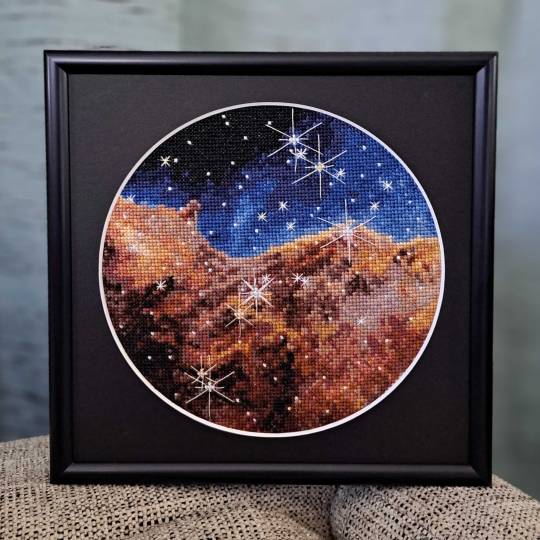
Wendy Edwards, a project coordinator with Earth Science Data Systems at NASA, created this embroidered piece inspired by Webb’s Carina Nebula image. Captured in infrared light, this image revealed for the first time previously invisible areas of star birth. Credit: Wendy Edwards, NASA. Pattern credit: Clare Bray, Climbing Goat Designs
Wendy Edwards, a project coordinator with Earth Science Data Systems at NASA, first learned cross stitch in middle school where she had to pick rotating electives and cross stitch/embroidery was one of the options. “When I look up to the stars and think about how incredibly, incomprehensibly big it is out there in the universe, I’m reminded that the universe isn’t ‘out there’ at all. We’re in it,” she said. Her latest piece focused on Webb’s image release of the Carina Nebula. The image showcased the telescope’s ability to peer through cosmic dust, shedding new light on how stars form.
Ocean Color Imagery: Exploring the North Caspian Sea
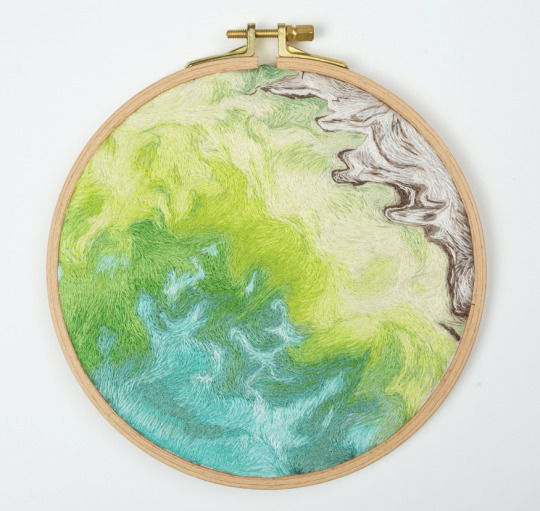
Danielle Currie of Satellite Stitches created a piece inspired by the Caspian Sea, taken by NASA’s ocean color satellites. Credit: Danielle Currie/Satellite Stitches
Danielle Currie is an environmental professional who resides in New Brunswick, Canada. She began embroidering at the beginning of the Covid-19 pandemic as a hobby to take her mind off the stress of the unknown. Danielle’s piece is titled “46.69, 50.43,” named after the coordinates of the area of the northern Caspian Sea captured by LandSat8 in 2019.
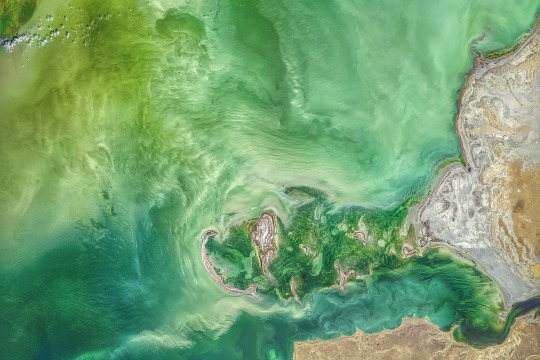
An image of the Caspian Sea captured by Landsat 8 in 2019. Credit: NASA
Two Hubble Images of the Pillars of Creation, 1995 and 2015
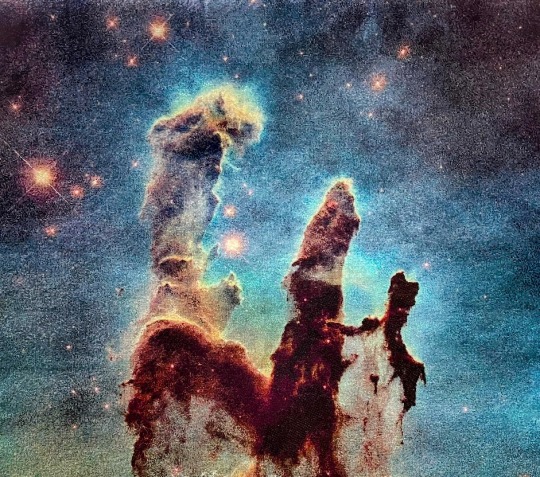
Melissa Cole of Star Stuff Stitching created an embroidery piece based on the Hubble image Pillars of Creation released in 1995. Credit: Melissa Cole, Star Stuff Stitching
Melissa Cole is an award-winning fiber artist from Philadelphia, PA, USA, inspired by the beauty and vastness of the universe. They began creating their own cross stitch patterns at 14, while living with their grandparents in rural Michigan, using colored pencils and graph paper. The Pillars of Creation (Eagle Nebula, M16), released by the Hubble Telescope in 1995 when Melissa was just 11 years old, captured the imagination of a young person in a rural, religious setting, with limited access to science education.
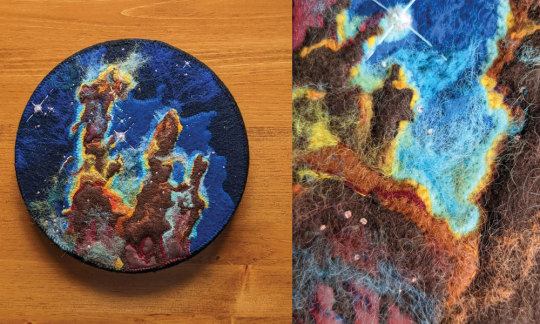
Lauren Wright Vartanian of the shop Neurons and Nebulas created this piece inspired by the Hubble Space Telescope’s 2015 25th anniversary re-capture of the Pillars of Creation. Credit: Lauren Wright Vartanian, Neurons and Nebulas
Lauren Wright Vartanian of Guelph, Ontario Canada considers herself a huge space nerd. She’s a multidisciplinary artist who took up hand sewing after the birth of her daughter. She’s currently working on the illustrations for a science themed alphabet book, made entirely out of textile art. It is being published by Firefly Books and comes out in the fall of 2024. Lauren said she was enamored by the original Pillars image released by Hubble in 1995. When Hubble released a higher resolution capture in 2015, she fell in love even further! This is her tribute to those well-known images.
James Webb Telescope Captures Pillars of Creation
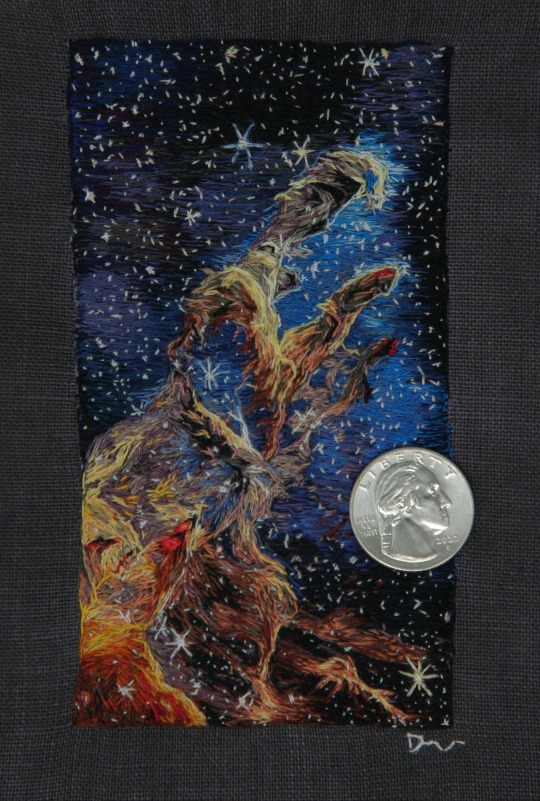
Darci Lenker of Darci Lenker Art, created a rectangular version of Webb’s Pillars of Creation. Credit: Darci Lenker of Darci Lenker Art
Darci Lenker of Norman, Oklahoma started embroidery in college more than 20 years ago, but mainly only used it as an embellishment for her other fiber works. In 2015, she started a daily embroidery project where she planned to do one one-inch circle of embroidery every day for a year. She did a collection of miniature thread painted galaxies and nebulas for Science Museum Oklahoma in 2019. Lenker said she had previously embroidered the Hubble Telescope’s image of Pillars of Creation and was excited to see the new Webb Telescope image of the same thing. Lenker could not wait to stitch the same piece with bolder, more vivid colors.
Milky Way
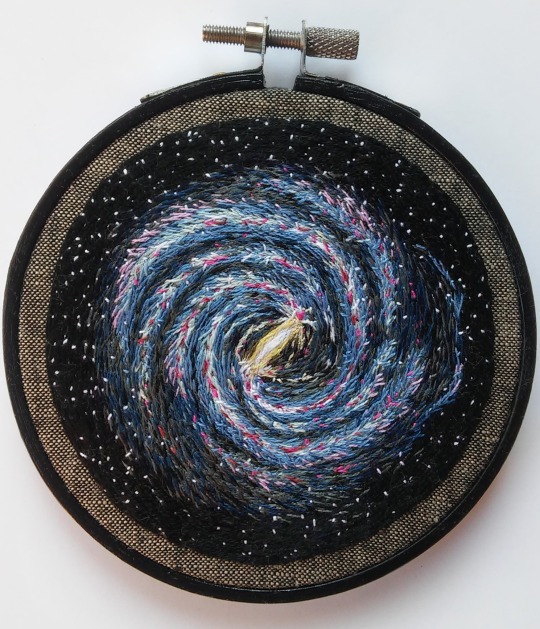
Darci Lenker of Darci Lenker Art was inspired by NASA’s imaging of the Milky Way Galaxy. Credit: Darci Lenker
In this piece, Lenker became inspired by the Milky Way Galaxy, which is organized into spiral arms of giant stars that illuminate interstellar gas and dust. The Sun is in a finger called the Orion Spur.
The Cosmic Microwave Background
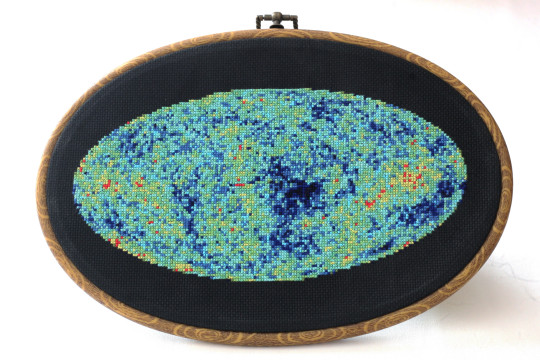
This image shows an embroidery design based on the cosmic microwave background, created by Jessica Campbell, who runs Astrostitches. Inside a tan wooden frame, a colorful oval is stitched onto a black background in shades of blue, green, yellow, and a little bit of red. Credit: Jessica Campbell/ Astrostitches
Jessica Campbell obtained her PhD in astrophysics from the University of Toronto studying interstellar dust and magnetic fields in the Milky Way Galaxy. Jessica promptly taught herself how to cross-stitch in March 2020 and has since enjoyed turning astronomical observations into realistic cross-stitches. Her piece was inspired by the cosmic microwave background, which displays the oldest light in the universe.

The full-sky image of the temperature fluctuations (shown as color differences) in the cosmic microwave background, made from nine years of WMAP observations. These are the seeds of galaxies, from a time when the universe was under 400,000 years old. Credit: NASA/WMAP Science Team
GISSTEMP: NASA’s Yearly Temperature Release
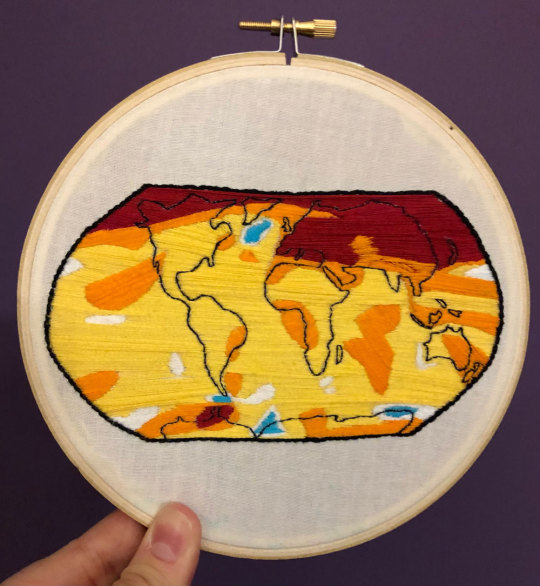
Katy Mersmann, a NASA social media specialist, created this embroidered piece based on NASA’s Goddard Institute for Space Studies (GISS) global annual temperature record. Earth’s average surface temperature in 2020 tied with 2016 as the warmest year on record. Credit: Katy Mersmann, NASA
Katy Mersmann is a social media specialist at NASA’s Goddard Space Flight Center in Greenbelt, Md. She started embroidering when she was in graduate school. Many of her pieces are inspired by her work as a communicator. With climate data in particular, she was inspired by the researchers who are doing the work to understand how the planet is changing. The GISTEMP piece above is based on a data visualization of 2020 global temperature anomalies, still currently tied for the warmest year on record.
In addition to embroidery, NASA continues to inspire art in all forms. Check out other creative takes with Landsat Crafts and the James Webb Space telescope public art gallery.
Make sure to follow us on Tumblr for your regular dose of space!
#NASA#creativity#fiber art#embroidery#art#art challenge#needlework#crafts#handmade#textile art#cross stitch#stitching#inspiration#inspo#Earth#Earth science#Hubble#James Webb Space Telescope#climate change#water#nebula#stars
6K notes
·
View notes
Text
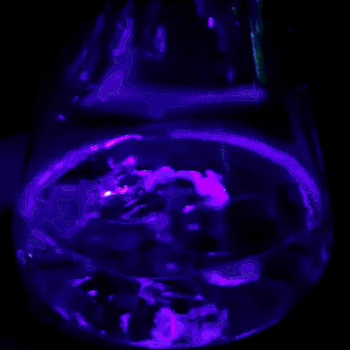
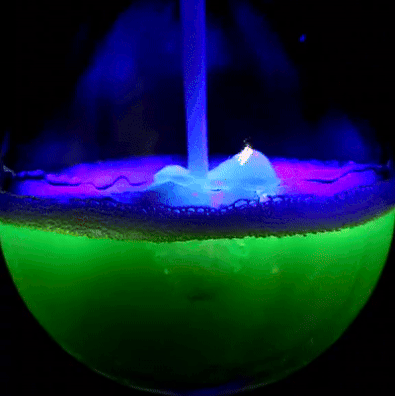
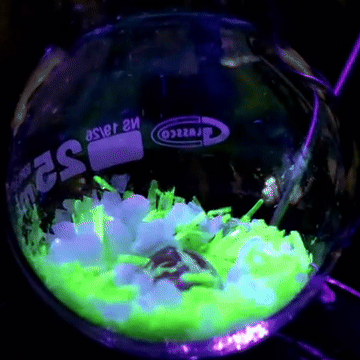
💚💜 ~ Green and Purple Chemistry ~ 💜💚
🧪...🧪...🧪
#neon#glowing#stim#chemistry stim#chemistrycore#glowcore#neoncore#purple and green#green and purple#Sciencecore#chemistry#chemistry aesthtic#science stim#science aesthetic#liquid#liquid stim#black light#blacklight#fluorescent#glow#glowwave#glow stim#Liquid stim#liquidcore#watercore#water stim#mad scientist#mad scientist aesthetic#mad science#evil science
1K notes
·
View notes